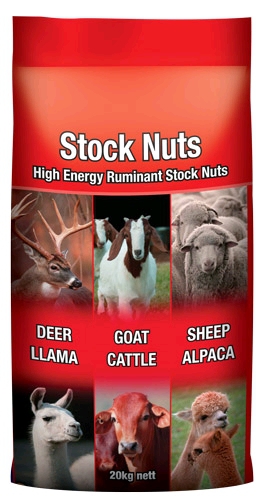Stock Nuts are formulated from a selection of the following ingredients: Barley, wheat, triticale, oats, rice, peas, lupins, lentils, beans, soyabean, canola, sunflower and products derived from these ingredients. Vegetable oil, limestone, di-calcium phosphate, salt, acid buf, gypsum, bentonite, magnesium sulphate, magnesium oxide and antioxidants. Vitamins: A, D3, E. Minerals: Calcium, phosphorus, sodium, chloride, cobalt, copper, iodine, iron, manganese, selenium and zinc.
The feeding rate of Stock Nuts will vary depending on a number of factors such as body weight and condition, pregnancy, lactation (level of milk production), activity and quality of the roughage being fed. Generally the total daily feed consumption, including roughage, will be between 2% to 3.5% of body weight for cattle, sheep, goats and deer. Alpacas and llamas consume less, being approximately 1.2% to 2.5% of body weight. Consumption of Stock Nuts will generally be between 10% and 75% of the total feed consumed. Introduce Stock Nuts gradually and avoid sudden changes to diet as digestive problems may occur. If digestive problems occur reduce the amount of nuts being fed and increase roughage consumption until normal digestive activity returns. When feeding alpacas and llamas be aware they are prone to choke if they consume food too quickly. Feed in a manner that will slow their rate of consumption. Roughage and clean, fresh water must be available at all times.




